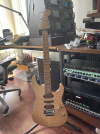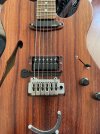hippietim
Axe-Master
I posted the picture below in a thread on another forum about the Guthrie Govan Charvel. A couple people made comments about the 3 Axe-Fx IIIs in the rack. @JiveTurkey was close when he asked if I had one for each string. This is going to be long-winded. Sorry.
I use three of them for multi-channel (hex) string processing. I've been into this sort of thing since Roland first came out with the GR synth guitars, then the spaceship MIDI guitar, VG, etc. I am currently using a couple Roland GK compatible guitars and a guitar I put Cycfi electronics in.
The standard Roland GK pickup sounds pretty wimpy compared to the Cycfi. Piezo equipped GK guitars are better than a Roland GK pickup. The GK stuff uses the somewhat finicky13-pin connector. I have a couple different breakout options for the GK guitars. Spicetone 6appeal which is a hex fuzz and also provides 6 string outputs. And I have a GKP-2 breakout box from Separate Strings in the UK.
The Cycfi pickups sound fantastic. It uses a very robust 19-pin connector into a breakout box which gives you individual string outputs (as well as other signals you want to pass from the guitar). It also has a Roland GK compatible output so you can use a VG-8, GR-55, SY-1000, etc.
I had run multi-channel guitar with the Axe-Fx III - the multi-channel feeds to stereo inputs 2, 3, and 4. It was fun but there's only really enough blocks of each type to have two full discrete paths. And the trick with multi-channel string processing is you need up to 6 of each effect you want to apply to each string. This can get expensive and/or complicated in a hurry. I looked into a whole bunch of products like the Eventide H8000/H9000, using multiple pedals, getting a bunch of older multi-effects units, etc.
I decided to give the Eventide H9000 a try. It's ridiculously expensive even when you buy the non-display unit. So it should be great. Right? Holy crap was that thing a nightmare to operate. Their software was an absolute nightmare. It took forever to get it working with Windows and it never worked with a Mac (their forum at the time confirmed all sorts of problems). Despite having USB ports, you literally could not connect the unit via USB. It only supported a network connection (they include a Wi-Fi dongle). It was hours of frustration to get this working. Once it was working, it wasn't stable. And rebooting and reconnection this thing took forever. Once it was working, it sounded glorious. Really. It sounds fantastic. But it turned out to be surprisingly inflexible in terms of signal routing and combining effects. If you're used to fairly flexible effect ordering and signal routing like you get with a Fractal, Helix, or Boss GT the H9000 was pretty limited.
I returned the H9000 and started thinking of my next move. Duh. Lightbulb moment. I already had an Axe-Fx III and getting two more was still substantially cheaper than the H9000. So I got two more Axe-Fx IIIs. And I do realize how insane this sounds as I am typing this. But it ends up being a super flexible setup with pretty much no limits that I can come up with.
The way these things are connected is pretty sweet. I use Inputs 3 and 4 on each unit for one string each. This gives me a full compliment of blocks for every single string.
The units are connected together via S/PDIF so everything stays in the digital domain:
Axe-FX A - strings 1 & 2 via inputs 3 & 4
Axe-FX B - strings 3 & 4 via inputs 3 & 4, strings 1 & 2 via S/PDIF in
Axe-FX C - strings 5 & 6 via inputs 3 & 4, strings 1, 2, 3, 4 via S/PDIF in
So Axe-FX C is the final output and a good place to apply global reverb and such.
It's hilarious amounts of fun. Here's a quick clip I made testing the Windows video screen capture feature today.

I use three of them for multi-channel (hex) string processing. I've been into this sort of thing since Roland first came out with the GR synth guitars, then the spaceship MIDI guitar, VG, etc. I am currently using a couple Roland GK compatible guitars and a guitar I put Cycfi electronics in.
The standard Roland GK pickup sounds pretty wimpy compared to the Cycfi. Piezo equipped GK guitars are better than a Roland GK pickup. The GK stuff uses the somewhat finicky13-pin connector. I have a couple different breakout options for the GK guitars. Spicetone 6appeal which is a hex fuzz and also provides 6 string outputs. And I have a GKP-2 breakout box from Separate Strings in the UK.
The Cycfi pickups sound fantastic. It uses a very robust 19-pin connector into a breakout box which gives you individual string outputs (as well as other signals you want to pass from the guitar). It also has a Roland GK compatible output so you can use a VG-8, GR-55, SY-1000, etc.
I had run multi-channel guitar with the Axe-Fx III - the multi-channel feeds to stereo inputs 2, 3, and 4. It was fun but there's only really enough blocks of each type to have two full discrete paths. And the trick with multi-channel string processing is you need up to 6 of each effect you want to apply to each string. This can get expensive and/or complicated in a hurry. I looked into a whole bunch of products like the Eventide H8000/H9000, using multiple pedals, getting a bunch of older multi-effects units, etc.
I decided to give the Eventide H9000 a try. It's ridiculously expensive even when you buy the non-display unit. So it should be great. Right? Holy crap was that thing a nightmare to operate. Their software was an absolute nightmare. It took forever to get it working with Windows and it never worked with a Mac (their forum at the time confirmed all sorts of problems). Despite having USB ports, you literally could not connect the unit via USB. It only supported a network connection (they include a Wi-Fi dongle). It was hours of frustration to get this working. Once it was working, it wasn't stable. And rebooting and reconnection this thing took forever. Once it was working, it sounded glorious. Really. It sounds fantastic. But it turned out to be surprisingly inflexible in terms of signal routing and combining effects. If you're used to fairly flexible effect ordering and signal routing like you get with a Fractal, Helix, or Boss GT the H9000 was pretty limited.
I returned the H9000 and started thinking of my next move. Duh. Lightbulb moment. I already had an Axe-Fx III and getting two more was still substantially cheaper than the H9000. So I got two more Axe-Fx IIIs. And I do realize how insane this sounds as I am typing this. But it ends up being a super flexible setup with pretty much no limits that I can come up with.
The way these things are connected is pretty sweet. I use Inputs 3 and 4 on each unit for one string each. This gives me a full compliment of blocks for every single string.
The units are connected together via S/PDIF so everything stays in the digital domain:
Axe-FX A - strings 1 & 2 via inputs 3 & 4
Axe-FX B - strings 3 & 4 via inputs 3 & 4, strings 1 & 2 via S/PDIF in
Axe-FX C - strings 5 & 6 via inputs 3 & 4, strings 1, 2, 3, 4 via S/PDIF in
So Axe-FX C is the final output and a good place to apply global reverb and such.
It's hilarious amounts of fun. Here's a quick clip I made testing the Windows video screen capture feature today.

Last edited:



